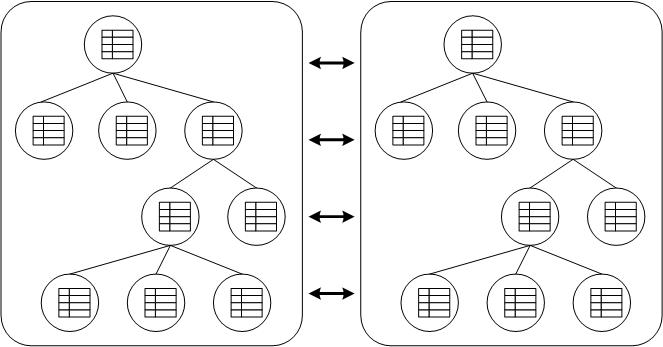JBoss Cache是一款基于Java的事务处理缓存系统,它的目标是构建一个以Java框架为基础的集群解决方案,可以是服务器应用,也可以是Java SE应用。

集群高可用性
JBoss Cache将会自动复制缓存数据,并且在集群中的服务器之间进行缓存数据的同步,这样可以保证任何一台服务器重启了都不会影响缓存的可用性。
集群缓存可避免系统瓶颈
JBoss Cache顾名思义是利用缓存来提高系统扩展性的,当我们的WEB系统遇到大量的数据库读写时,系统的瓶颈将会出现在数据库端,JBoss Cache正好可以解决数据库的频繁读取问题,解决这个瓶颈。
另外,由于JBoss Cache的缓存是在集群中的每一个服务器间同步的,因此也不会因为一台缓存服务器遇到性能问题而影响整个系统。
JBoss Cache的standalone用法
首先是初始化TreeCache
- TreeCache tree = new TreeCache();
然后是读进配置文件
- PropertyConfigurator config = new PropertyConfigurator();
- config.configure("配置文件.xml");
然后开始服务
- Tree.startService();
因为Tree的结构是用NODE来Access的,TreeCache这里就很简单的用:
/level1/level2/node1 来表示两级Tree下面的Node1。
现在我们添加几个要Cache的对象。
- Tree.put("/level1/level2/node1", "key1", "value1");
- String[] array = { "1", "2", "3", "4" }
- Tree.put("/level3/array/", "myarray", array);
大家可以看到,TreeCache里面可以存储任何种类的对象,包括所有复杂对象。
读取对象就很方便了,
- String s = (String)Tree.get("/level1/level2/node1/", "key1");
value1就读出来了。
同理:
- String[] sarr = (String[]) Tree.get("/level3/array/","myarray");
System.out.println(sarr[1]) 会显示2
最后停止服务:
- Tree.stopService();
JBoss Cache的FileCacheLoader示例
首先创建一个FileCache类封装JBoss Cache的相关操作,如下:
- package com.javaeye.terrencexu.jbosscache;
- import java.io.File;
- import java.util.Map;
- import org.jboss.cache.Cache;
- import org.jboss.cache.DefaultCacheFactory;
- import org.jboss.cache.Fqn;
- import org.jboss.cache.Node;
- import org.jboss.cache.config.CacheLoaderConfig;
- import org.jboss.cache.config.Configuration;
- import org.jboss.cache.loader.FileCacheLoader;
- import org.jboss.cache.loader.FileCacheLoaderConfig;
- /**
- * <p>
- * This is demo to illustrate how to use the JBoss Cache to cache your
- * frequently accessed Java objects in order to dramatically improve
- * the performance of your applications. This makes it easy to remove
- * data access bottlenecks, such as connecting to a database.
- * </p>
- * <p>
- * As a rule of thumb, it is recommended that the FileCacheLoader not
- * be used in a highly concurrent, transactional or stressful environment,
- * ant its use is restricted to testing.
- * </p>
- *
- * @author TerrenceX
- *
- * @param <T>
- */
- public class FileCache<T> {
- /**
- * The JBoss Cache, used to cache frequently accessed Java objects.
- */
- private Cache<String, T> cache;
- /**
- * @constructor
- * @param fsCacheLoaderLocation The file system location to store the cache
- */
- public FileCache(File fsCacheLoaderLocation) {
- cache = initCache(fsCacheLoaderLocation);
- }
- /**
- * Create a Cache and whose cache loader type is File Cache Loader
- *
- * @param fsCacheLoaderLocation The file position used to store the cache.
- *
- * @return Cache
- */
- public Cache<String, T> initCache(File fsCacheLoaderLocation) {
- // initiate a FileCacheLoader instance
- FileCacheLoader fsCacheLoader = new FileCacheLoader();
- // prepare the file cache loader configuration file for File Cache Loader
- FileCacheLoaderConfig fsCacheLoaderConfig = new FileCacheLoaderConfig();
- fsCacheLoaderConfig.setLocation(fsCacheLoaderLocation.toString());
- fsCacheLoaderConfig.setCacheLoader(fsCacheLoader);
- // set configuration to File Cache Loader
- fsCacheLoader.setConfig(fsCacheLoaderConfig);
- // prepare the configuration for Cache
- Configuration config = new Configuration();
- config.setCacheLoaderConfig(new CacheLoaderConfig());
- config.getCacheLoaderConfig().addIndividualCacheLoaderConfig(fsCacheLoaderConfig);
- // create a Cache through the default cache factory
- return new DefaultCacheFactory<String, T>().createCache(config);
- }
- /**
- * Add a new node into the tree-node hierarchy
- *
- * @param fqn Full Qualified Name for the new node
- * @return
- */
- public Node<String, T> addNode(Fqn<String> fqn) {
- return cache.getRoot().addChild(fqn);
- }
- /**
- * Remove a specified node from the tree-node hierarchy
- *
- * @param fqn Full Qualified Name for the specified node
- */
- public void removeNode(Fqn<String> fqn) {
- cache.removeNode(fqn);
- }
- /**
- * Add node information to the specified node.
- *
- * @param fqn Full Qualified Name for the specified node
- * @param key The key of the node information
- * @param value The value of the node information
- */
- public void addNodeInfo(Fqn<String> fqn, String key, T value) {
- cache.put(fqn, key, value);
- }
- /**
- * Batch add node information to the specified node.
- *
- * @param fqn Full Qualified Name for the specified node
- * @param infos Node informations map
- */
- public void addNodeInfos(Fqn<String> fqn, Map<String, T> infos) {
- cache.put(fqn, infos);
- }
- /**
- * Get node information from the specified node.
- *
- * @param fqn Full Qualified Name for the specified node
- * @param key The key of the node information
- * @return
- */
- public T getNodeInfo(Fqn<String> fqn, String key) {
- return cache.get(fqn, key);
- }
- /**
- * Remove node information from the specified node.
- *
- * @param fqn Full Qualified Name for the specified node
- * @param key The key of the node information
- */
- public void removeNodeInfo(Fqn<String> fqn, String key) {
- cache.remove(fqn, key);
- }
- }
下面是一个测试案例:
- package com.javaeye.terrencexu.jbosscache;
- import java.io.File;
- import org.jboss.cache.Fqn;
- public class Main {
- public static void main(String[] args) {
- FileCache<String> fileCache = new FileCache<String>(new File("d:\\tmp"));
- Fqn<String> jimmyFqn = Fqn.fromString("/com/manager/jimmy");
- Fqn<String> hansonFqn = Fqn.fromString("/com/developer/hanson");
- fileCache.addNode(jimmyFqn);
- fileCache.addNode(hansonFqn);
- fileCache.addNodeInfo(jimmyFqn, "en-name", "Jimmy Zhang");
- fileCache.addNodeInfo(jimmyFqn, "zh-name", "Zhang Ji");
- fileCache.addNodeInfo(hansonFqn, "en-name", "Hanson Yang");
- fileCache.addNodeInfo(hansonFqn, "zh-name", "Yang Kuo");
- String enName = fileCache.getNodeInfo(hansonFqn, "en-name");
- System.out.println(enName);
- }
- }
运行结果如下:
- - JBossCache MBeans were successfully registered to the platform mbean server.
- - JBoss Cache version: JBossCache 'Malagueta' 3.2.5.GA
- Hanson Yang
生成的缓存文件目录结构如下:
- D:/tmp/com.fdb/manage.fdb/jimmy.fdb/data.dat
- D:/tmp/com.fdb/developer.fdb/hanson.fdb/data.dat
总结
JBoss Cache还有更多的用法,如果你的系统遇到数据库瓶颈问题,可以考虑使用JBoss Cache来解决。

























